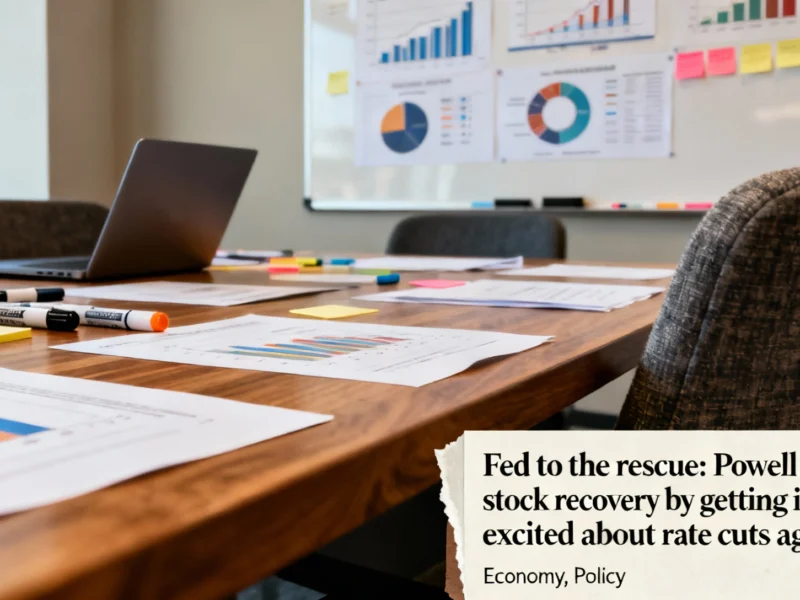Dramatic Market Reversal Following Powell’s Comments
The stock market experienced one of its most dramatic intraday reversals of the year on Tuesday, with the Dow Jones Industrial Average swinging nearly 1,000 points from session lows to close significantly higher. What began as a concerning sell-off transformed into a powerful rally after Federal Reserve Chair Jerome Powell delivered remarks that investors interpreted as strongly dovish toward future interest rate policy.
Major indexes had fallen approximately 1% in the first hour of trading, with the sell-off appearing likely to continue throughout the session. However, a ferocious turnaround began in the afternoon hours, ultimately pushing the Dow up by 400 points after having been down 600 points earlier in the day. This marked a crucial recovery for stocks that would have represented their second down day in the last three trading sessions.
Powell’s Key Remarks That Sparked the Rally
Speaking before the National Association for Business Economics in Philadelphia, Powell focused his comments on labor market conditions, noting that “the labor market continues to show signs of weakening.” While he didn’t specifically mention monetary policy in his prepared remarks, investors immediately interpreted his assessment of employment conditions as signaling increased likelihood of rate cuts.
“In this less dynamic and somewhat softer labor market, the downside risks to employment appear to have risen,” Powell stated during his address. “While official employment data for September are delayed, available evidence suggests that both layoffs and hiring remain low, and that both households’ perceptions of job availability and firms’ perceptions of hiring difficulty continue their downward trajectories.”
Market Reaction and Rate Cut Expectations
The market’s response was immediate and powerful, with trading volumes surging as investors repositioned their portfolios based on the perceived shift in Fed policy direction. Data from the CME Group now shows investors are pricing in two additional 25-basis-point rate cuts by the end of 2025, with a third cut expected by the Fed’s March 2026 meeting. Perhaps most significantly, the probability of a rate cut at the Fed’s October 29 meeting has jumped to 96%.
This dramatic shift in expectations reflects how Powell’s comments were received as strong confirmation of the Fed’s willingness to act preemptively to support economic stability. The market interpretation suggests that the Chair of the Federal Reserve and the broader Federal Open Market Committee are increasingly concerned about economic momentum and prepared to provide accommodative policy.
Expert Analysis and Market Strategist Perspectives
JPMorgan’s Chief Economist Michael Feroli reinforced the market’s interpretation, stating that Powell’s remarks “all but confirmed a rate cut at the next meeting.” In a client note circulated Tuesday, Feroli wrote: “While there was little doubt the FOMC was angled to cut rates at its next meeting, today’s remarks were strong confirmation of that expectation.”
David Russell, Global Head of Market Strategy at TradeStation, highlighted additional dovish elements in Powell’s commentary beyond the labor market assessment. “Jerome Powell highlighted the eventual end of quantitative tightening and noted potential liquidity issues. These comments push the narrative in a more dovish direction,” Russell noted in an email analysis. “He also suggested that tariffs aren’t causing inflation. Powell isn’t waiting to get in the holiday spirits. Christmas might come early from the Fed.”
Broader Economic Context and Labor Market Dynamics
The focus on labor market conditions places Powell’s comments firmly within the realm of labour economics, where subtle shifts in employment trends can signal broader economic transitions. The Fed Chair’s emphasis on weakening labor conditions suggests the central bank is closely monitoring employment metrics as key indicators for policy adjustments.
This approach aligns with the Fed’s dual mandate of maximum employment and price stability, with current conditions apparently tilting the balance toward supporting employment growth. The market’s enthusiastic response indicates that investors view this policy orientation as appropriate given current economic crosscurrents and potential growth headwinds.
Global Central Bank Context and Policy Coordination
The Federal Reserve’s potential policy shift comes amid similar considerations by other major central banks worldwide. Recent statements from the Bank of England Governor Bailey have emphasized productivity growth as a key policy consideration, suggesting coordinated attention to sustainable economic expansion among global monetary authorities.
Meanwhile, as central banks navigate complex economic landscapes, businesses and consumers face their own challenges in adapting to changing conditions. The impending end of Windows 10 support represents the type of technological transition that businesses must manage alongside economic uncertainty, highlighting the multifaceted nature of current operational environments.
Market Implications and Forward Outlook
The dramatic market reversal triggered by Powell’s comments suggests that investor sentiment remains highly sensitive to Fed policy signals. The swift repricing of rate expectations demonstrates how quickly market narratives can shift based on central bank communication, particularly from the Fed Chair.
Additional insights from the Bank of England’s focus on productivity growth reinforce that major central banks are coordinating around sustainable economic expansion strategies. This global perspective suggests that monetary policy adjustments may be part of a broader international effort to maintain economic stability amid evolving growth dynamics.
Looking forward, market participants will closely monitor upcoming economic data releases and Fed communications for confirmation of the policy direction signaled by Tuesday’s remarks. The strong market response indicates that investors are positioning for a more accommodative policy environment, with potential implications across asset classes and economic sectors.



